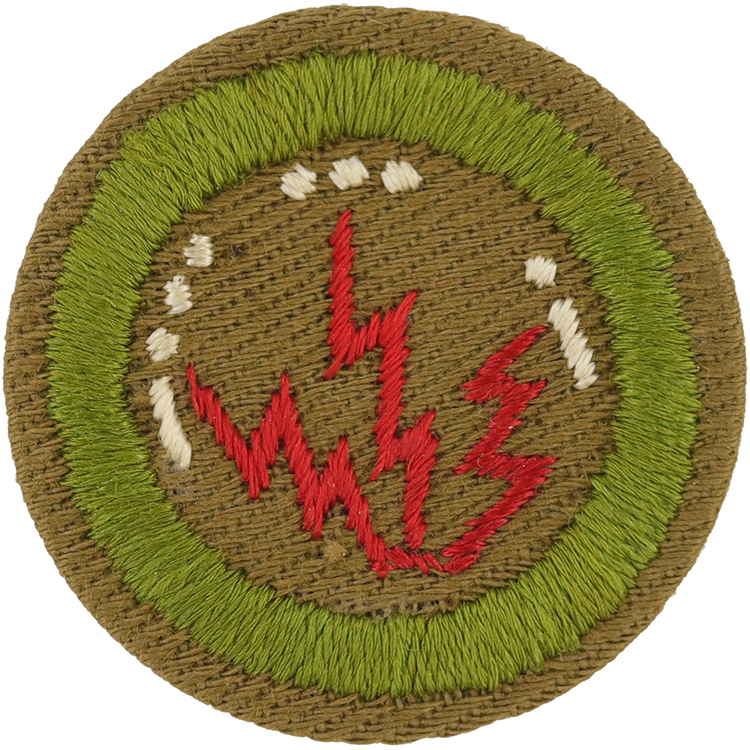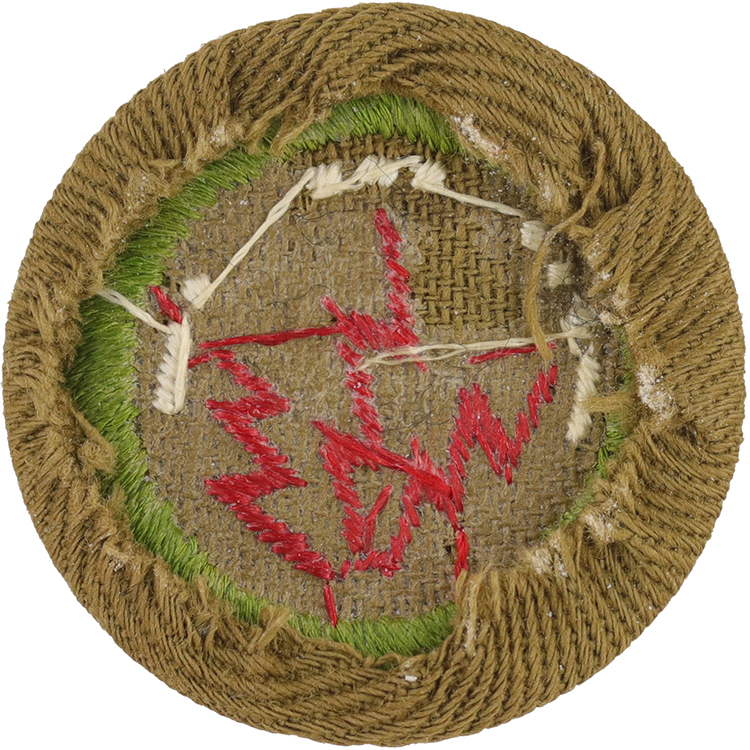
Fig. 1: Radio-C4-Front
- Cloth: Lightweight tan right twill
- Embroidery: Cotton loop continuous

Fig. 2: Radio-C4-Reverse
- Back: Plain NO imprint with starch
Item Name: Radio 1939 - 1943
Item ID: Radio-C4
Collector Rating: 1
Pamphlets Used to Earn this Badge


Requirements November 1932 until May 1940
1. Receive and send correctly a message of not less than five words per minute.
2. (a) Explain how and what he would transmit in order to establish communication with another station.
(b) Make up a sample radiogram including the body of the message.
3. Tell what the United States Radio Laws state about wave length, power, operating hours and kinds of apparatus for amateur radio stations; whether a license is necessary for all such stations; whether the operator needs a license; how one knows what call to use at an amateur station.
4. Write down 10 of the most important "Q" signals, and give the meaning of each.
5. Draw from memory, using correct symbols, the circuit diagram for a low power, short wave transmitting set. Describe each part of the apparatus and explain briefly its purpose. Explain how to use a wave meter in connection with this transmitting apparatus to obtain radiation on the proper wave length.
6. Draw from memory, using correct symbols, a wiring diagram of a complete receiving set, using a vacuum tube detector, and one stage audio frequency amplifier showing all essential apparatus and including antenna and telephones. Describe each part of the apparatus and explain briefly its purpose.
7. Explain the difference between continuous waves and modulated or interrupted continuous waves.
8. Construct with his own hands a practical working receiving set and demonstrate its operations for receiving signals from a station 25 or more miles away.
9. Submit satisfactory evidence that he has located and repaired a fault in a receiving set.
10. Explain how to install an antenna, how to connect it for use on a sending and receiving set, how to ground it properly and how to protect it against lightning and power wires.
NOTE.--The holding of a first grade amateur operator's license and a regular or special amateur station license will exempt the holder from examination on counts 1, 2, 3 and 4. Both the operator's license and the station license must be presented before the local Court of Honor and shown to be in force at the time the Badge is awarded.
Requirements December 1940 until December 1942
1. Receive and send correctly a straight text at not less than five words (25 letters) per minute.
2. Know what, if any, licenses are required by Federal Law for the operation of (a) a receiving station; (b) a transmitting station.
3. Know at least five of the most frequently used "Q" signals. Explain the meaning of each.
4. (a) Draw a wiring diagram of a complete receiving set for use on short wave with vacuum tube detector and one stage amplifier. Use correct symbols and show all essential apparatus, including antenna and telephones. Describe each detail of apparatus and explain briefly the use of each.
(b) Using the above diagram, explain how this receiving set could be made to operate also as a miniature transmitter.
5. Construct a working receiving set and demonstrate its operation by receiving signals from at least ten different stations.
6. Explain how to install an antenna for use in receiving equipment and how to ground it properly and protect it against lightning and power wires.
NOTE: The holding of a first grade amateur operator's license and a regular or special amateur station license will exempt the holder from examination on all requirements above except 4. (a) and (b) and 5. Such licenses must be in force at the time the Badge is awarded.
Requirements December 1942 until April 1950
1. Receive and send correctly a straight text at not less than five words (25 letters) per minute.
2. Know what, if any, licenses are required by Federal Law for the operation of (a) a receiving station; (b) a transmitting station.
3. Know at least five of the most frequently used "Q" signals. Explain the meaning of each.
4. (a) Draw a wiring diagram of a complete receiving set for use on short wave with vacuum tube detector and one stage amplifier. Use correct symbols and show all essential apparatus, including antenna and telephones. Describe each detail of apparatus and explain briefly the use of each.
(b) Using the above diagram, explain how this receiving set could be made to operate also as a miniature transmitter.
5. Construct a working receiving set and demonstrate its operation by receiving signals from at least ten different stations.
6. Explain how to install an antenna for use in receiving equipment and how to ground it properly and protect it against lightning and power wires.
NOTE: The holding of an amateur operator's license will exempt the holder from examination on all requirements above except 4. (a) and (b) and 5. Such licenses must be in force at the time the Badge is awarded.
